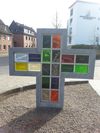

|
|
|
|
|
|
List
Limburg 1940-1945,
Main Menu
The fallen resistance people in Limburg
Eduardus Servatius Valentinus Maria Rutten (Eduard)
∗ 12-08-1923 Maastricht † 23-04-1945 Flossenbürg, (21)
- Maastricht - Forced Labor - Studenten - People in hiding -

- https://www.nationaalarchief.nl/onderzoeken/index/nt00446/60df64a8-a136-11e8-828a-00505693001d?searchTerm=Rutten
- Buchenwald • Dachau •
- KZ Flossenbürg, Wikipedia • Nederlands • Deutsch • English • Français • Português
- Todesmärsche, Wikipedia • Nederlands • Deutsch • English • Français • Español
- Todesmärsche 1945 in Niederbayern
- Arbeitskreis Heimatgeschichte Mitterfels
Mitterfels und der 25. April 1945
Schwester M. Tabitha Popp; Guido Scharrer: Kalenderblatt vom 25. April 1945: Zeitzeugen berichten vom Kriegsende und KZ-Todesmarsch (mitterfels-online.de)
Scharrer Guido: Todesmärsche aus dem KZ Flossenbürg durch die Stadt Straubing und den Landkreis, Straubing 1995 - Open Street Map
1. Flossenbürg
2. Obergraßlfing – Grafentraubach
3. Rattiszell – Stallwang - Oorlogsgravenstichting.nl
- http://www.maastrichtsegevelstenen.nl/0.OORLOG/oorlog2c-verzet.htm
Picture: Wikimedia →→→
Three of Eduard Rutten’s older brothers were in hiding, and he himself probably as well, as he was a student. He was arrested in Maastricht during a search in his parents’ home. The family had previously lived in Schinnen, his father’s birthplace. [1] The same form from his file at the oorlogsgravenstichting (War Graves Foundation) in the National Archives, presumably filled out by the municipality of Maastricht, states that he was arrested by the SS. The following questions are answered as well:
8. Date of departure for Germany: July 1944
9. Cause of stay in Germany: Employed in Germany after house search. (Three older brothers, students, were in hiding.) After attempted escape he was broug to B(uchenwald) [2] in Germany.
The person who filled this out does not know anything about a grave. But:
probably he died during a transport of sick people from Buchenwald camp to Dachau or during an extermination transport from Buchenwald. He was on a transport at the beginning of April 1945.
The persons who worked on this form seem to have had a problem to tell Dachau [2] and Flossenbürg [3] apart. Flossenbürg was not a subcamp of Dachau, but it was established from Dachau under the same system. The form originally indicated as place of death: Dachau. To that was added: area of Flossenbürg. That is a long way north. [7.1]
It is also not clear, if he was deported in a sick transport, or if he had to leave on foot.
The explanation for this confusion lies in the great chaos and panic, which broke out among the SS camp guards with the approach of the Allied troops.
The extermination transport, mentioned in the form, refers to one of the many death marches (Todesmärsche) [4], which the SS sent out toward the end of the Nazi dictatorship, in order to get rid of as many prisoners as possible, spread over a fairly large area along the roads.
According to an order from Himmler, no concentration camp prisoners were to fall alive into the hands of the Allies. [6]
Concerned were Jews, but also many forced laborers. One of these marches went from Buchenwald to Dachau. Perhaps Eduard Rutten was also among them. We read about it on the German Wikipedia under the title Todesmärsche 1945 in Niederbayern [5]:
The 1945 death marches in Lower Bavaria were the death marches of concentration camp prisoners from Flossenbürg concentration camp in the final phase of World War II.
At the end of April 1945, a death march took place from Buchenwald near Weimar to Dachau with about 100-150 prisoners, which passed through the two villages of Obergraßlfing and Grafentraubach on the way. The local population was willing to help the weak and emaciated prisoners, as long as the SS guards did not intervene.
…
Grafentraubach, Graßlfing
On the road between Obergraßlfing and Grafentraubach [7.2] 21 prisoners were shot. Their bodies were buried on the spot and later transferred to the municipal cemetery Allkofen and finally in the cemetery of honor in Steinrain.
About April 23, 1945, which is given in his file as his date of death, it says:
Stallwang/Rattiszell [7.3]
On April 23, 1945, about 3,000 prisoners passed through Stallwang. A total of 24 prisoners perished, scattered throughout the village. The villagers buried the bodies in a makeshift manner. They were later ordered by the Americans to dig up the bodies again and bury them in dignity in the cemetery. However, the death march did not continue via Mitterfels, but directly to Straubing. Also on April 23, 1945, the procession passed through Rattiszell. A total of 34 dead were recorded here: 21 dead on the death march via Straubing and 13 on the march via Mitterfels/Bogen. One march also came from Hankenzell, where five dead were found exactly at the site of the memorial stone and 19 more in the vicinity of the stone. [5]
Two days after Eduard’s official death date, one of those death marches passed through the village of Mitterfels. You can find an article about it on the local website: Mitterfels und der 25. April 1945 [6]
Perhaps in one of those villages is his final resting place.
Footnotes
